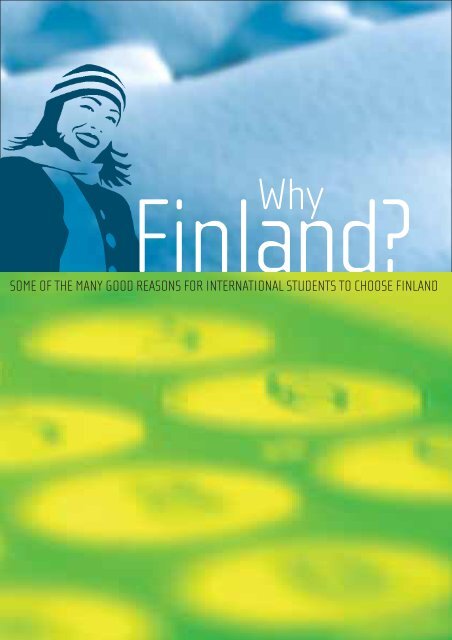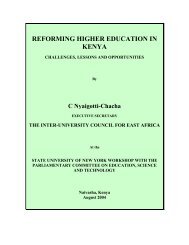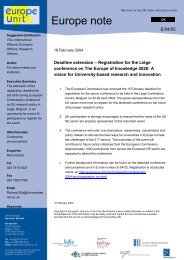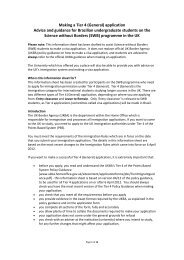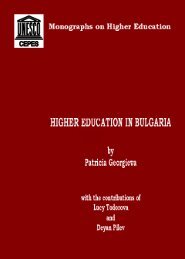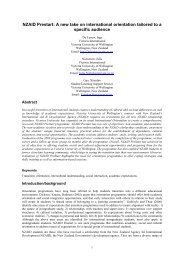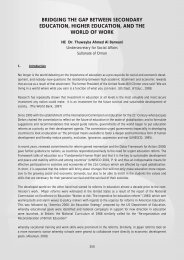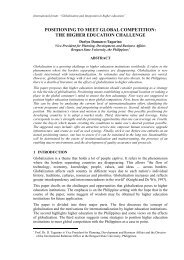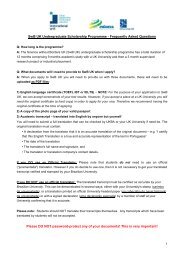Why Finland?
Why Finland?
Why Finland?
You also want an ePaper? Increase the reach of your titles
YUMPU automatically turns print PDFs into web optimized ePapers that Google loves.
<strong>Finland</strong>?<br />
<strong>Why</strong><br />
SOME OF THE MANY GOOD REASONS FOR INTERNATIONAL STUDENTS TO CHOOSE FINLAND
<strong>Why</strong> <strong>Finland</strong>?<br />
3
<strong>Why</strong> <strong>Finland</strong>?<br />
• High standards of higher education maintained through quality assurance<br />
as part of the Bologna process<br />
• All 20 universities and 29 polytechnics are internationally oriented with special<br />
regional features<br />
• Internationally acclaimed expertise in many areas: ICT, biotechnology,<br />
forestry and environmental sciences, architecture and design<br />
• Young Finns among the world’s best in terms of learning outcome according<br />
to PISA-research<br />
Higher education is provided by 20 universities and 29 polytechnics situated in almost every<br />
corner of the country. All of these institutions are internationally oriented, with good services<br />
for foreign students.<br />
Ten of the twenty universities are multidisciplinary institutions and ten are specialist ones<br />
(three universities of technology, three business schools and four art academies). All<br />
universities are involved in both education and research and award doctorates.<br />
The polytechnics (most of them call themselves universities of applied sciences) form<br />
a practically oriented system of higher education. They award Bachelor and Master lever<br />
higher education degrees emphasizing close contact with business and industry. These<br />
institutions always include a period of practical training in their programmes. Most of the<br />
polytechnics are multi-faculty, regional establishments.<br />
<strong>Finland</strong>’s education<br />
system is efficient and<br />
well-organised.”<br />
<strong>Finland</strong>’s education system is efficient and well-organised. The overall performance of the<br />
country’s higher education institutions is constantly monitored, and performance-based<br />
funding is used to reward institutions for high-quality education and research. Finnish<br />
universities are state institutions and are overseen by the Ministry of Education. Universities<br />
of applied sciences are mainly maintained by municipalities or federations of municipalities.<br />
In <strong>Finland</strong> education is highly valued. The population of 5.2 million people is small but welleducated.<br />
No wonder, because although the population density of <strong>Finland</strong> is among the lowest,<br />
its network of higher education institutions is among the densest in Europe. This means that<br />
practically anywhere in <strong>Finland</strong> it is possible to study in the areas in which the country has<br />
internationally acclaimed expertise.<br />
For the time being there are no tuition fees for students enrolled in degree programmes at<br />
Finnish universities. Most international programmes do not charge tuition fees either. The<br />
student unions at the universities may, however, charge a membership fee of 65-100 euros<br />
to cover services such as counselling and healthcare. The student card also gives students<br />
discounts for a wide range of other services.<br />
5
<strong>Finland</strong> offers an outstanding<br />
possibility to enrich<br />
one’s academic proficiency ”
<strong>Why</strong> <strong>Finland</strong>?<br />
• Over 350 international study programmes taught in English<br />
• Courses ranging from short-term programmes to complete degree programmes<br />
• Bachelor’s, Master’s and Doctor’s degree programmes<br />
• An excellent choice of subjects spanning from high-tech know-how to fine arts<br />
• ECTS (European Credit Transfer System) adopted in September 2005<br />
You don’t have to know any Finnish to study in <strong>Finland</strong>. There are over 350 international study<br />
programmes taught in English, and the scope of these programmes is extensive in both to the<br />
subjects taught and the length of the course. Study opportunities range from interdisciplinary<br />
programmes (such as Russian and East European studies) and intercultural studies to those<br />
of high-tech know-how, marketing and engineering, as well as design and fine arts.<br />
Depending on the time you have available and your particular needs, your choice spans from<br />
short-term courses through to complete degree programmes requiring several years of fulltime<br />
study.<br />
The lower academic degree is the Bachelor’s degree, which takes approximately three years<br />
to accomplish. The higher degree i.e. Master’s degree takes two additional years. Full-time<br />
studies for a doctorate take approximately four years following completion of a Master’s<br />
degree.<br />
“<strong>Finland</strong> gives me a feeling<br />
that it is a safe place, and<br />
I mean all aspects of safety.”<br />
Lev Shagal, 24, Israeli<br />
studying at the Helsinki Business Polytechnic Helia<br />
The quality of scientific research in <strong>Finland</strong> is high. Systematic professional research training<br />
is available at over one hundred graduate schools, which are attached to Finnish universities<br />
and cover all the main areas of research. Students attend top-level intensive courses and<br />
receive research tutoring from <strong>Finland</strong>’s leading research teams, which work in close<br />
collaboration with other national and international research centres.<br />
Some institutions of higher education offer complete post-graduate degree programmes in<br />
English. There are also scholarships for study in <strong>Finland</strong> for post-graduate students and<br />
researchers. For example, the Centre for International Mobility CIMO awards scholarships to<br />
young researchers (post-graduates who have completed their Master’s degree or post-doctoral<br />
students) for study at Finnish universities. The programme is open to young researchers from<br />
all countries in all academic fields.<br />
For this and other scholarships, further information is given on the Discover <strong>Finland</strong> website<br />
at http://finland.cimo.fi.<br />
7
<strong>Why</strong> <strong>Finland</strong>?<br />
• Good opportunities for practical training relating to your studies<br />
• Placements in Finnish companies with an international profile<br />
• A wide range of programmes from technology to marketing and tourism<br />
• Programmes designed for students and recently graduated persons over 18<br />
years of age<br />
• Training periods varying from one-month summer placements to a maximum of<br />
18 months<br />
In order to add a Finnish dimension to your studies you don’t have to actually study in <strong>Finland</strong>.<br />
Instead, you could complete a practical training period here.<br />
If you choose training in <strong>Finland</strong> you will have a unique opportunity to experience Finnish<br />
culture, commerce and industry, education and technological expertise first-hand.<br />
Training opportunities in <strong>Finland</strong> are available for both full-time students who have completed<br />
at least one year at a university, university of applied sciences or vocational college, and<br />
graduates who been out of school for less than two years. The selection of placements ranges<br />
from environmental technology and ICT applications to marketing and tourism. Assistant<br />
teaching posts are also available for native speakers of English, French, Spanish or German.<br />
The standard of Finnish<br />
universties is high and<br />
supervision of studies<br />
really works"<br />
The training period is directly related to the student’s particular field of study. Previous work<br />
experience in the field is desirable but not always a requirement. The training normally takes<br />
place during the summer months (June-August), but is also possible in the winter.<br />
The minimum training period is one month and the maximum is 18 months. Students are<br />
required to have a working knowledge of English, Swedish or Finnish.<br />
Trainee exchanges are arranged by various organisations: CIMO and its contact organisations,<br />
student organisations, universities etc. You can also come to <strong>Finland</strong> as a trainee via some<br />
of the European community action programmes i.e. Leonardo da Vinci and Socrates/Comenius<br />
2.2.<br />
9
<strong>Why</strong> <strong>Finland</strong>?<br />
• Free access to well-equipped library and computer services<br />
• Range of services provided for international students including orientation,<br />
academic counselling and language courses<br />
• Excellent support from teachers and individualised supervision for students<br />
• A wide range of activities offered by student unions<br />
The Finnish institutions for higher education receive a lot of praise from foreign students and<br />
experts for the high standard of their facilities.<br />
Buildings are modern and functional, libraries are well-stocked and equipped with computer<br />
services and internet access, and the latest developments in information technology are<br />
integrated into every field of study.<br />
A whole variety<br />
of courses<br />
I wouldn't have been<br />
able to take<br />
elsewhere"<br />
Foreign students also enjoy the efficient yet relaxed atmosphere in the Finnish universities<br />
and polytechnics. Teachers are easy to approach and they are committed to supporting their<br />
students throughout their studies. Finnish universities organize language courses for foreign<br />
students in both Finnish and Swedish, <strong>Finland</strong>’s two official languages.<br />
The student unions and other student organizations arrange tutoring, a variety of courses<br />
and informal leisure activities.<br />
They will do their best to ensure that you get the most out of your time in <strong>Finland</strong>!<br />
11
Nature is an integral<br />
part of the Finnish way<br />
of life because it is<br />
everywhere.”
<strong>Why</strong> <strong>Finland</strong>?<br />
An inspiring cross-cultural environment: Western tradition enriched with Eastern<br />
influences combined with a Nordic lifestyle<br />
• A peaceful, well-organised country<br />
• As one of the Nordic countries, <strong>Finland</strong> respects democracy and human rights<br />
• One of the world’s most competitive economies, according to many rankings<br />
• Straightforward, English-speaking people<br />
In <strong>Finland</strong>, you can experience a way of life that combines a dynamic urban culture with a<br />
richly diverse natural environment. <strong>Finland</strong> is also a high-tech society that quickly explores<br />
the advantages of the latest technological advances.<br />
<strong>Finland</strong> is an EU member state and a Nordic republic with two official languages: Finnish and<br />
Swedish. The country is situated between West and East, bordering Sweden, Norway and Russia<br />
by land and Estonia by sea. During its history, <strong>Finland</strong> has been part of Sweden and an<br />
autonomous Grand Duchy under the Russian Tsar before gaining independence in 1917. If we<br />
add to this the fact that about 20 percent of the country lies above the Arctic Circle, the picture<br />
of <strong>Finland</strong>’s unique position on the world map starts to take shape. All this is naturally reflected<br />
in the Finnish culture, traditions, cuisine, way of life, and in the character of the people.<br />
According to surveys, foreigners consider Finns very friendly, polite and helpful, though a bit<br />
shy. Finnish society is stable and well-organised, and English is widely spoken, especially<br />
among younger people, so even if you don’t speak a word of Finnish or Swedish you won’t have<br />
difficulties communicating.<br />
Nature is an integral part of the Finnish way of life because it is everywhere. Approximately<br />
70 percent of the land is covered by forest, and there are about 188,000 lakes, 1,100 km of<br />
coastline and around 81,000 islands off the coast. The archipelago that lies between mainland<br />
<strong>Finland</strong> and Sweden is the largest in Europe. The country is 1,160 km long: the terrain in<br />
Lapland, the northernmost part of <strong>Finland</strong>, is tundra while the middle and southern parts of<br />
the country are lush and green and dotted with thousands of lakes.<br />
<strong>Finland</strong> has four distinctive seasons, which are clearly reflected in the Finnish rhythm of life.<br />
In Finnish Lapland, the northernmost part of the country, the sun doesn’t set for around eight<br />
weeks in summer, whereas in winter it doesn’t rise above the horizon for several months. So<br />
in summer Finns enjoy the long days under the midnight sun, while the winter is a time for<br />
the magic of the Aurora Borealis and polar nights of silver moonlight glistening on virgin<br />
snow.<br />
As to the culture, Finns are very active as producers and consumers of all that it has to offer.<br />
In this country of eager readers, the libraries are very well-stocked with literature, magazines<br />
and newspapers, not only in Finnish but in other languages too. In <strong>Finland</strong> you can always go<br />
to the cinema because foreign films are not dubbed in Finnish but shown with subtitles. And<br />
there are restaurants, café'8es, bars and clubs to suit every taste.<br />
The capital of <strong>Finland</strong> is Helsinki - a small metropolis in a scenic location on the shores of the<br />
Baltic Sea. Great architecture, a lively cultural scene and of course its own beautiful natural<br />
surroundings are just waiting to be explored.<br />
13
We hope that you've now got some idea of how you could make use of the excellent study<br />
opportunities <strong>Finland</strong> has to offer!<br />
Now you know why to come to <strong>Finland</strong>. Still there is one question left to answer:<br />
how to do it?<br />
As an exchange student, please contact the international affairs office at your own institution<br />
for more information. Exchange students can come to <strong>Finland</strong> through European Union<br />
programmes, such as Socrates/Erasmus and Leonardo da Vinci. Students from the USA can<br />
participate in the ISEP exchange programme, while students from the other Nordic countries<br />
can take advantage of the Nordplus scheme. Finnish institutions of higher education have<br />
bilateral agreements with colleges and universities abroad, which also cover exchange<br />
programmes. In special cases, students can be accepted from outside the above-mentioned<br />
schemes.<br />
• If you have a complete degree in mind, please contact directly the institution you are<br />
interested in attending. As a general rule, international applicants for degree studies in <strong>Finland</strong><br />
must first meet the minimum requirements of their own country for entry into higher education.<br />
They must also be prepared to come to <strong>Finland</strong> to take an entrance exam, especially when<br />
applying for entry to universities. For further information visit the Discover <strong>Finland</strong> website<br />
at http://finland.cimo.fi<br />
• If you are a post-graduate student and interested in participating in a post-graduate degree<br />
programme taught in English in a Finnish institution of higher education, please contact<br />
directly the institution you are interested in. You can find them listed by field of study on the<br />
Discover <strong>Finland</strong> website at http://finland.cimo.fi (studying | international study programmes).<br />
• If you are interested in practical training in <strong>Finland</strong>, you can obtain more information from<br />
your university through the local branch of the student organizations responsible for arranging<br />
trainee placements, or through CIMO’s contact organization in your country. A list ofCIMO’s<br />
partners is on the Discover <strong>Finland</strong> website at http://finland.cimo.fi (practical training).<br />
Since it takes four to five months to find a suitable placement, it is wise to apply approximately<br />
six months before the beginning of your planned work period. The deadline for applications<br />
for many of CIMO’s programmes is February 15th each year.<br />
• The Finnish Embassies and Consulates around the world will help you with the necessary<br />
formalities related to coming to <strong>Finland</strong> for study, such as applications for visas and<br />
other permits. The list of the Finnish Diplomatic Missions abroad is on the web at<br />
Remember to reserve enough time to complete all the necessary formalities such as<br />
arranging visas and other permits before your departure!<br />
• You’ll probably find the answers to most of your questions concerning the<br />
various opportunities <strong>Finland</strong> has to offer in the fields of higher education, research<br />
and practical training on CIMO’s Discover <strong>Finland</strong> website at http://finland.cimo.fi.<br />
In case you need more information, please contact CIMO.<br />
The Centre for International Mobility CIMO is at your service!<br />
14
why<br />
so,<br />
not?<br />
ISBN 951-805-091-0<br />
First editon, 7.000<br />
Libris, Helsinki 2/2006<br />
Layout and illustration: Private Eye Oy<br />
Photos: Comma Image Oy
Centre for International Mobility CIMO<br />
P.O. Box 343 (Hakaniemenkatu 2)<br />
FI-00531 Helsinki, <strong>Finland</strong><br />
Tel. +358 9 7747 7033<br />
Fax + 358 9 7747 7064<br />
E-mail cimoinfo@cimo.fi<br />
http://finland.cimo.fi (Discover <strong>Finland</strong>)<br />
Telephone service<br />
for international clients:<br />
+358 1080 6767<br />
(Mon-Thu 10.00–12.00 and 13.00–15.00)


